Home Freezing of Vegetables
FNH-00264 View this publication in PDF form to print or download.
Freezing is one of the easiest, most convenient and least time-consuming methods of preserving foods. Freezing keeps the natural color, fresh flavor and nutritive qualities of most foods better than other known methods of preservation. Although freezing does not sterilize food, the extreme cold retards the growth of microorganisms and slows down chemical changes that affect quality or cause food to spoil.
Top Quality Frozen Vegetables
To maintain top quality, frozen vegetables should be stored at 0°F or lower. Most refrigerator-freezer combinations and separate freezer units should have no trouble in maintaining this temperature. A freezer thermometer can help you determine the actual temperature of your freezer. These thermometers are relatively inexpensive and generally available at hardware or grocery stores.
If your freezer has numbered temperature settings, such as from 1 to 9, check the owner’s manual to see what settings are recommended for different uses. Storing frozen foods at temperatures higher than 0°F increases the rate at which deterioration can take place and can shorten the shelf life of the foods.
Containers for Freezing
Foods for your freezer must be properly packaged to protect their flavor, color, moisture content and nutritional value from the dry climate of the freezer. To prevent loss of quality and nutrients, freezing must be rapid. Therefore, it is best not to freeze vegetables in containers with a capacity over one-half gallon as the foods freeze too slowly to result in a satisfactory product.
The selection of containers depends on the type of food to be frozen, personal preference and availability of certain types. There are two types of packaging materials for home use: rigid containers and flexible freezer bags or wrappings.
Rigid Containers
- Made of plastic or glass
- Suitable for all packs and especially good for liquid packs
- Often reusable
- Make stacking of foods easier
If using glass jars, choose wide-mouth, dual-purpose jars made for freezing and canning. These jars have been tempered to withstand extremes in temperatures.
Covers for rigid containers should fit tightly. If they do not, freezer tape can be used to reinforce the seal.
Flexible Freezer Bags or Wrapping Materials
Dry-packed products with little or no liquid and foods with irregular shapes can be preserved using flexible freezer bags or wrappings. Wrapping materials include
- plastic freezer wrap,
- freezer paper, and
- heavy-weight aluminum foil.
Plastic freezer bags are available in a variety of sizes and work well for liquid packs. Use bags labeled for freezer use. Regular storage bags are thinner and suitable for short-term refrigerator storage only. When packaging, make sure to eliminate air pockets. Press to remove as much air as possible before closing.
Vacuum Sealer
Dry packs and frozen vegetables may be packaged using a vacuum sealer. Vacuum packaging removes more air from the packages than could be pressed out and seals the air out. Carefully follow the directions that come with the vacuum sealer. To avoid the risk of botulism from some vacuum-packaged foods, keep foods frozen until ready to use.
Blanching Chart
The size and density of the vegetable determines the time needed for heat to completely penetrate the food. Use the longer recommended blanching times for larger-sized vegetables.
| VEGETABLE | PREPARATION (size in inches) | HEATING TIME in boiling water (minutes) | COMMENTS |
|---|---|---|---|
| Beans, snap |
2 to 4 inches |
3 |
|
| Beet |
small whole medium whole |
25 to 30 45 to 50 |
cook until skin slips off, dice or slice |
| Broccoli |
1½-inch diameter spears chopped |
3 1½ to 2 |
peel stalks if desired |
| Brussels sprouts |
small heads medium heads |
3 4 |
trim outer leaves |
| Cabbage |
shredded or chopped |
1½ |
stir for even heating |
| Carrot |
small whole ¼-inch slices or strips |
5 2 |
|
| Cauliflower |
1-inch flowerets |
3 |
add 4 teaspoons of salt per gallon of water to prevent darkening |
| Celery |
1-inch lengths |
3 |
for cooking uses only |
| Corn, sweet |
whole cob kernels |
7 to 11 4 |
wrap each cob, then bag blanch on cob, then cut |
|
Greens including chard, collards, kale, mustard, spinach |
whole or chopped |
3 (collards) 2 (other greens) |
stir for even heating |
| Kohlrabi |
½-inch cubes |
1
|
peel |
| Onion |
whole bulb rings |
3 to 7 10 to 15 seconds |
for cooking uses only batter before freezing if desired |
| Parsnip |
½-inch cubes |
2 |
|
| Peas |
shelled edible pod sugar snap |
1½ 1½ to 2 2 to 3 |
wash in pan to float off debris |
| Pepper |
halved ½-inch strips |
3 2 |
blanching optional |
| Potato |
|
|
freezing is not recommended |
| Rutabaga |
½-inch cubes mashed |
3 until soft |
boil or steam chunks, then mash |
|
Squash, summer including zucchini |
½-inch slices grated |
3 1 to 2 (steam) |
freeze in measured amounts for baking |
|
Squash, winter including pumpkin |
mashed |
until soft |
bake, steam or boil, scrape from rind, and mash |
|
Tomato, stewed |
peeled, quartered |
until soft |
heat in own juices until cooked (10 to 20 minutes) |
|
Turnip |
½-inch cubes mashed |
2 until soft |
boil or steam chunks, then mash |
Preparing Vegetables for Freezing
For best results, products should be frozen as quickly as possible. To facilitate more rapid freezing, set the temperature control of your freezer at the coldest setting several hours before foods will be placed in the freezer. Some freezer manuals indicate the location of the coldest shelves in the freezer and suggest placing products on these shelves.
Prior to loading the freezer, check the freezer manual for instructions on recommended amounts of unfrozen product that can be frozen at one time. Generally, guidelines specify 2 to 3 pounds of food to each cubic foot of freezer space per 24 hours. Overloading the freezer with unfrozen products will result in a long, slow freeze and a poor quality product.
Blanching
Blanching is the first step in preparing vegetables for home freezing. The blanching process involves scalding vegetables in boiling water for a short time. Blanching
- stops enzyme actions that can cause loss of flavor, color and texture,
- cleanses the surface of dirt and organisms,
- brightens the color,
- helps retard the loss of vitamins, and
- softens the vegetables and makes them easier to pack.
Equipment and Supplies
- produce scale (optional)
- kitchen timer
- knife and/or vegetable peeler
- cutting board
- freezer bags, rigid freezer containers or glass jars made for freezing
- waterproof marker
For heating vegetables:
- blanching kettle that has a blanching basket and lid or
- large pot with lid and wire basket or metal colander that fits inside
For cooling vegetables:
- large bowl or pot
- colander
- plenty of fresh, cold water
- ice cubes (optional)
Step-by-Step Blanching Process
- Select produce that is young, tender, unwilted and garden fresh. Refrigerate fresh vegetables until you are ready to begin blanching.
- Prepare vegetables:
- Wash thoroughly in cold water.
- Trim stem ends.
- Peel root vegetables (except beets).
- Sort by size or cut into uniform-sized pieces so each batch heats evenly.
- Use 1 gallon water per pound of prepared vegetables. Over high heat, bring the water to a vigorous boil.
- Place about 1 pound of prepared vegetables into the blanching basket or colander. Lower into the boiling water. Vegetables should be completely immersed in the water.
- Place a lid on the kettle or pot. The water should return to boiling within 1 minute. If this is not the case, you are using too much vegetable for the amount of boiling water. Start counting blanching time or set kitchen timer as soon as the water returns to a boil. Blanching time is determined by the type of vegetable being processed. Keep heat high for the time recommended in the Blanching Chart provided in this publication
Note: Overblanching results in a cooked product. Underblanching can stimulate enzyme activity. Either error will reduce the quality of the frozen food.
- At the end of the recommended time, lift the vegetables out of the boiling water, drain momentarily and immediately plunge into a large quantity of cold water, 60°F or below.
Vegetables should be cooled for the same amount of time that they were heated. When processing several batches of vegetables, change the cooling water often or use ice cubes to keep the water cold.
To cool mashed vegetables, place in a shallow pan and set into a container of cold water. Stir occasionally to hasten cooling.
- After cooling, lift the vegetables out of the cold water. Let them drain in the blanching basket or transfer to a colander. Drain vegetables thoroughly after cooling. Extra moisture can cause a loss of quality when vegetables are frozen.
- Package prepared vegetables in the storage container of your choice. If using rigid freezer containers, leave ½ inch headspace to allow for the food to expand. Headspace is not needed for loosely packed foods such as broccoli spears.
- Label bags or containers with a waterproof marker. List the name of the product, the amount of product (cups, ounces or pounds) and the date processed.
- Place packages in the freezer. Arrange them loosely or in a single layer so they freeze quickly. Home-frozen vegetables have a storage time of 8 to 12 months when properly packaged and stored at 0°F. After this time, the food should still be safe, yet quality may be affected.
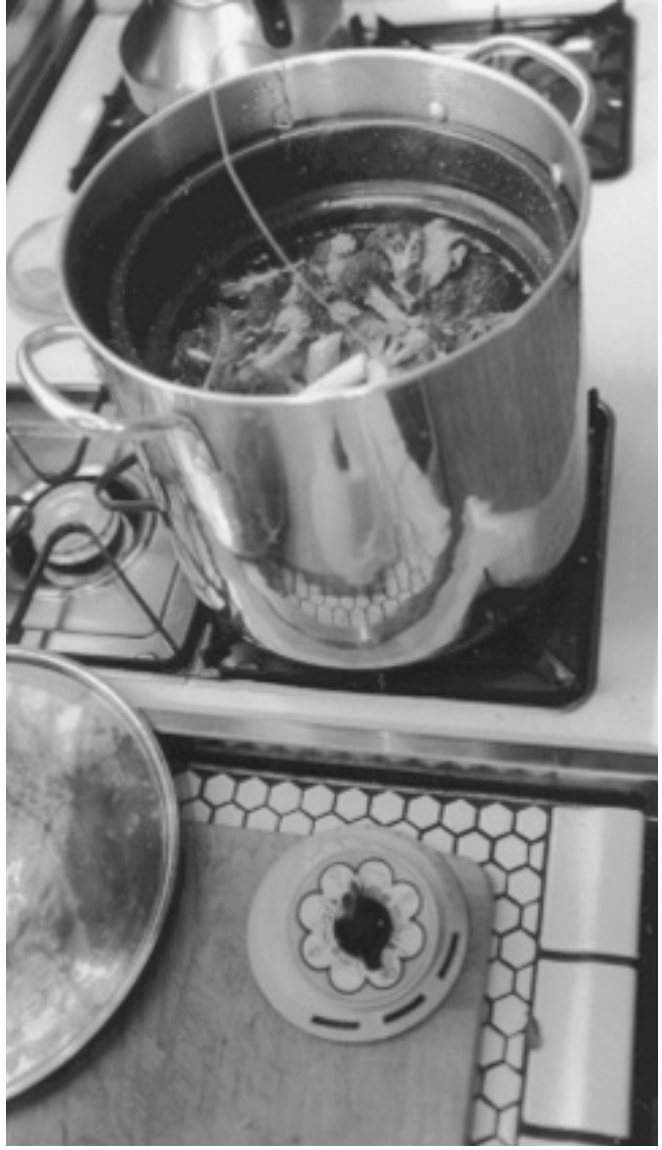
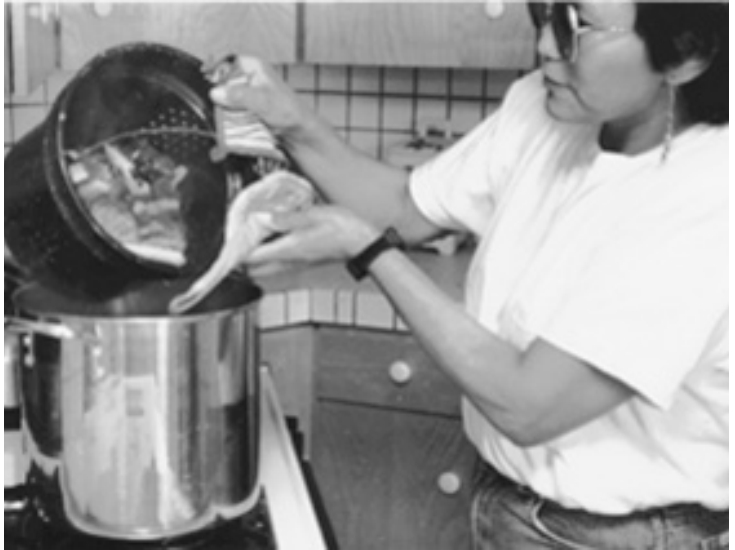
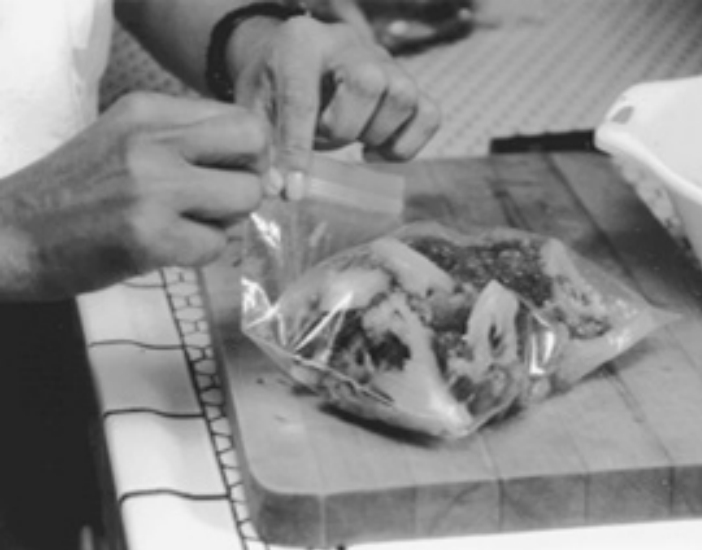
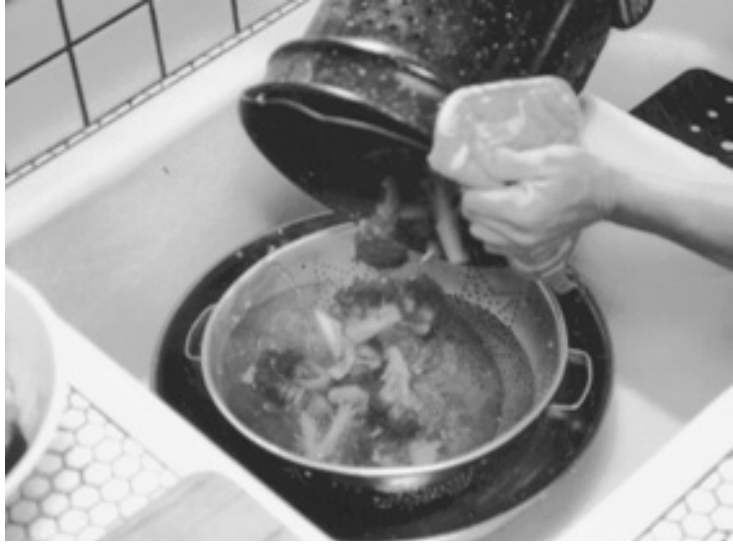
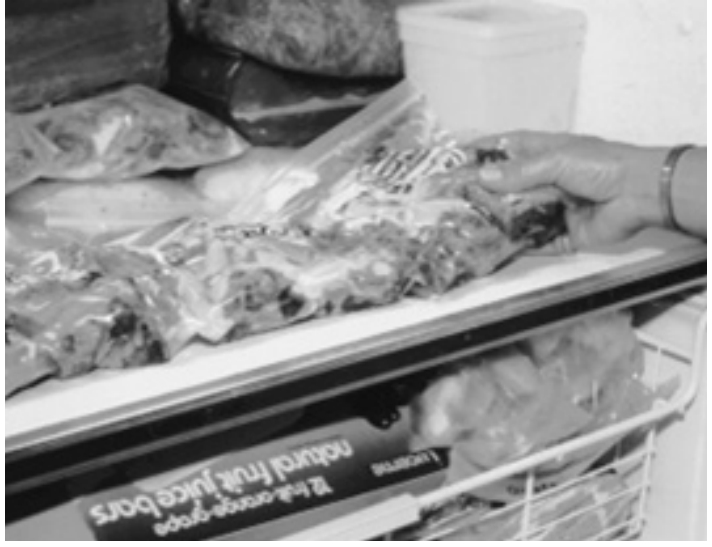
Leif Albertson, Extension Faculty, Health, Home and Family Development. Includes information from "So Easy to Preserve," 5th edition, University of Georgia/Athens Cooperative Extension and USDA "Home and Garden Bulletin No. 10." Photos by Tom Thompson, Tanana Chiefs Conference, Inc. Originally prepared by Gina Delucchi
Reviewed July 2020
